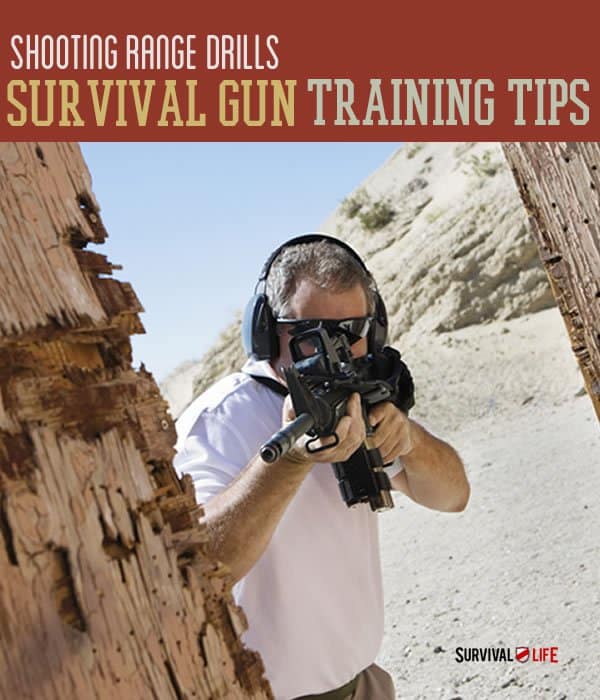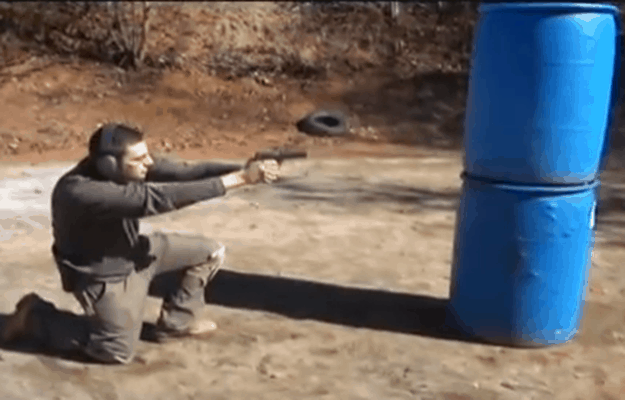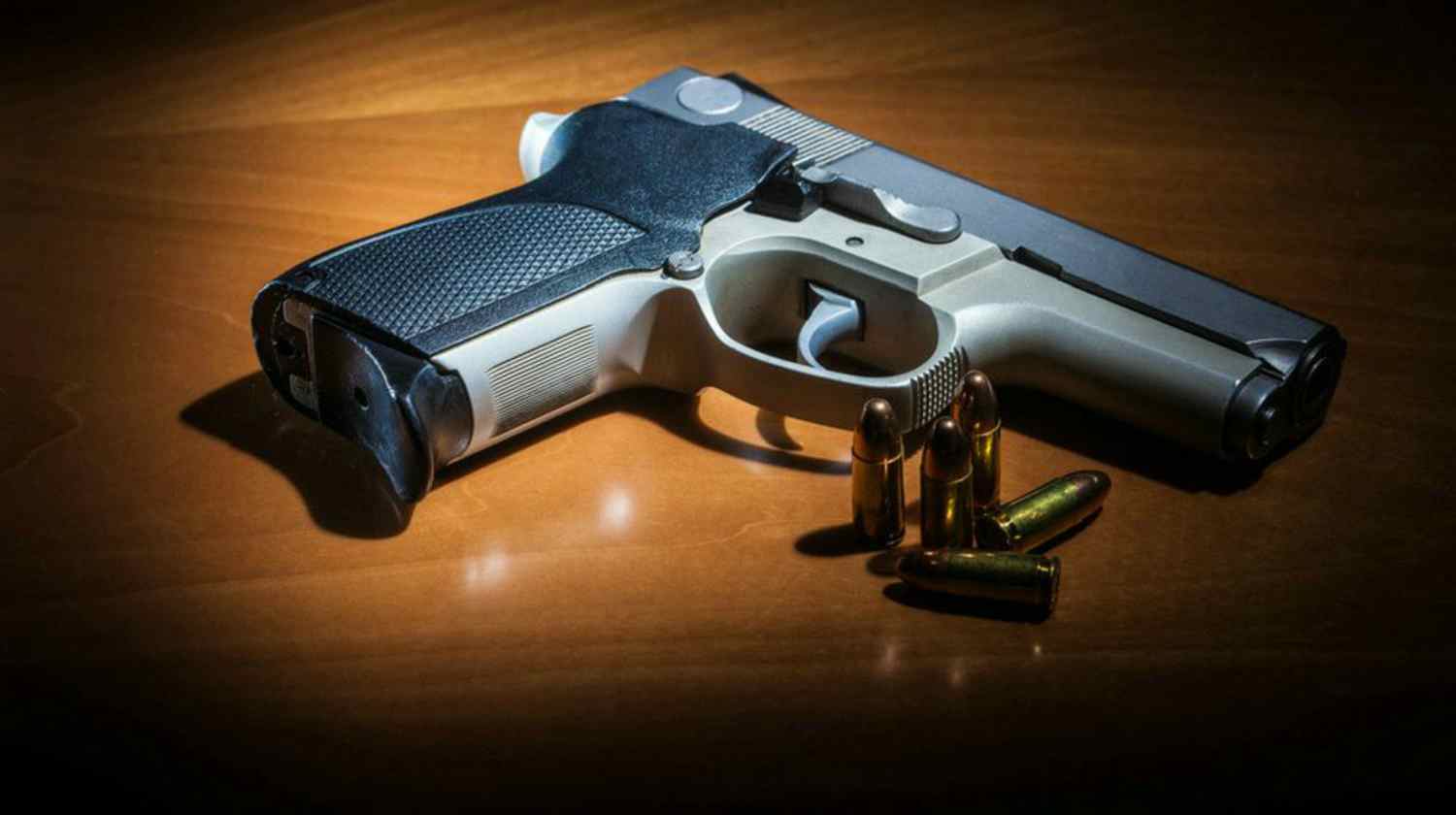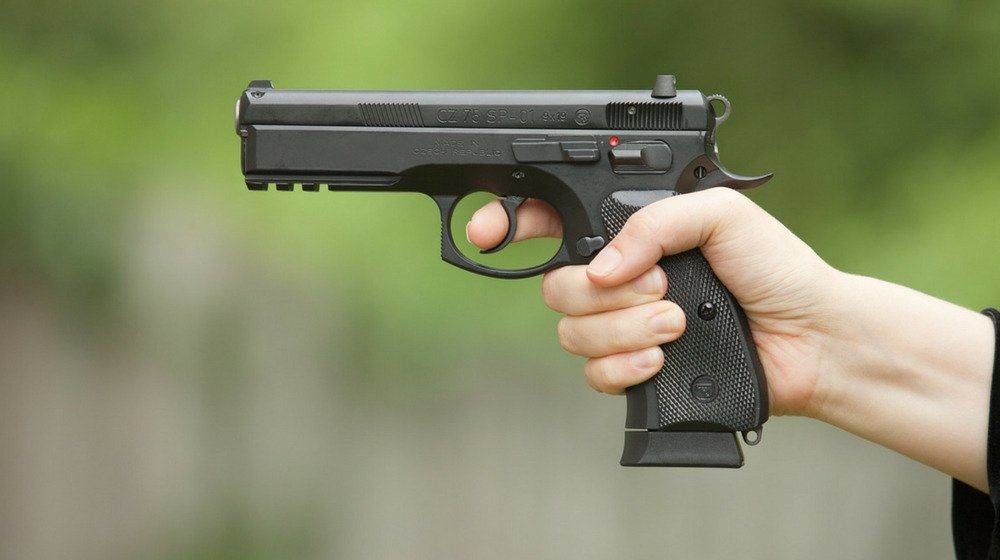Featured
Shooting Range Drills | Survival Gun Training Tips
Published
2 years agoon

“Dynamic shooting” kind of sounds like something the latest tactical ninja training DVD would be teaching. In reality, it's really not.
There are different types of shooting, the two main ones being dynamic and static.
Static shooting is simple target practice, an appropriate application of the fundamentals of marksmanship. Static shooting is what most of us do the majority of the time.
The second type, dynamic shooting, is where skills are sharpened in a variety of different ways. In dynamic shooting you learn to shoot in positions, situations, and utilizing techniques you may face in day-to-day situations. Dynamic shooting isn't the action movie jumping through the air while simultaneously firing two guns and making cars explode in slow motion.
Think of dynamic shooting as real-world shooting. Unfortunately, most ranges will not allow any kind of dynamic shooting, so a stretch of private land with an appropriate back stop or even access to a special range may be required. Of course, always take the appropriate safety measures and follow the four golden rules of firearm safety.
Basics of Dynamic Shooting
First off, everyone needs to practice shooting from different and sometimes unusual positions. In the real world you will never know what situation and position you'll find yourself in. Before you practice any of these techniques live, I suggest a healthy amount of dry fire and dry runs.
Let's start from the top and work our way down. Obviously, you practiced the standing position in static shooting. So now we'll focus on the low standing. In my Marine Corps career I found myself in bad places more often than I would like to remember, and got shot at many more time than I cared for. You will have an overwhelming urge to be as small as humanly possible. This means you are going to bend your knees and bend at your waist.
This isn't a very comfortable position, but once the bullets are in the air you'll be in it. You may be required to shoot in this position, so it's important to get a good feel for it. Start practicing your draw from this position, transition from draw to target acquisition and then pulling the trigger. Remember, start with dry fire and work your way to live fire.
If you feel masterful of this technique, try to dry fire while moving. I don't suggest live fire and movement until you've really mastered it.
Now when you get to cover what do you do? You get behind it. This is where training from a low firing position comes into play. A low position being from the knee, ultimately you should practice firing from both your left and your right knee. Now a simple board can be set up as “cover” for training situations.
Cover needs to vary between short and tall, to let shooters practice different levels of taking a knee. Practice should be done firing, over cover, and to the left and right of it. Always keep in mind that keeping your body behind cover as much as possible. Have a friend observe how much of your body is behind the cover, and refine and re-tune as necessary. Firing from cover, especially from lower positions of cover, is an important skill to master. Cover is what saves lives.
Shooting From The Ground
Different situations may occur where you find yourself on the ground. You may be knocked down before you can get your gun out. Practicing drawing from the ground and firing from your back can be an important skill. Trust me: The world looks a lot different from down there.
You can also practice shooting from a traditional prone shooting position, on your right and left side as well. This will build familiarization with a multitude of different angles.
Of course, practicing your draw is important, not only just getting the gun to clear leather, but the sights on target followed shortly by bullets on target. This is probably the most dangerous portion of shooting. That reason alone is why nearly every range bans the practice. So it's critical to practice drawing dry and dry firing.
Practice in the clothes you wear every day. If you wear a suit to work, practice shooting in a suit. If you don't want to risk ruining your nice suit, get an old one from a thrift store.
We All Have Unique Dynamics
Now, all of us have unique situations in which we live. Different jobs and different environments are going to place us in different situations. I can't possibly predict what your situation is. I'm going to use my situation as an example of how I built my training program for my life.
My day-to-day job has me in two different situations daily. I'm either in my office behind a computer or in a vehicle visiting customers, collecting money, and recovering merchandise. I'm armed constantly because I usually transport expensive electronics, jewelry and small amount of cash, usually below a thousand dollars, but enough to be robbed.
I typically carry in an under-the-shoulder holster because it's very easy to draw when seated, especially in a vehicle. So I train for this. I practice my draw from a seated position. I do practice shooting from a sitting position, and set up an old table and some cardboard boxes to simulate my computer.
I use some engineer tape or the orange tape sold at hardware stores to mark off water and gas lines to simulate the confines of my office, and to keep it as close as possible.
I'm still trying to figure out a way to practice shooting from the confines of a vehicle. Until then, I can practice a seated position firing through a narrow opening. Also, I can practice shooting through a larger opening in front of me and a smaller opening on the opposite side or me.
I practice shooting one handed in case one of my hands is occupied with a piece of merchandise, or the lockbox I store the cash in. I also practice dropping large boxes and making the transition to a handgun. No TV is worth my life, so I'm more than happy to drop it.
Building your dynamic shooting plan takes a careful examination of your life. It's actually quite fun when it's done safely, of course. Always follow the four rules of gun safety and always practice dry before going live. Dry firing and dry training can be just as important as doing it with live rounds. Remember to be safe, and have fun.
Tactical Gun Training That Can Save Your Life
A large percentage of firearms owners think that just owning a firearm is enough. Take it out, wave it in the face of an aggressor and they'll flee. If they don't turn tail and run, then anyone can shoot a gun after all, Hollywood actors do it all the time, right? Unfortunately, that isn't the case.
My wife recently got her concealed carry license. In the state where we live, this requires taking a class, passing both a proficiency test and a written test and getting a background check. Since we live in a “will issue” state, if you manage to get over those rather simple hurdles, the state will issue you the license. Even though my wife hadn't touched a gun a month before she took the course, she was still able to pass.
Defensive Pistol Training
Now, I'll have to say that before she took the class, I insisted that she learn how to shoot properly. So, I took my wife to the range twice a week and taught her. That was much better than the other women in her class, neither of whom had ever fired a gun before. They expected to learn how to shoot the gun in the concealed carry class.
While I realize that the case of those two women was a bit extreme, I also realize that it's not really all that uncommon. Many people buy guns and sign up for concealed carry classes, without really having any idea of how to shoot, or at least not knowing how to shoot well.
If you are going to use a gun, then you need to know how to use it well. While an assailant might have a gun just to scare you, it makes no sense at all for you to try the same thing with them. Doing so could get you killed. Pulling out a gun raises the stakes in the game, even though they already have one. It means that you are ready to shoot them to defend yourself. You don't want to send that signal if you can't do it.
There are two parts to being able to pull that trigger. The first one is having made the decision in your mind that you are ready and able to use deadly force to defend yourself and your family. Don't wait until someone is staring at you over their gun sights to decide that. You had better have that decision made long beforehand.
The second requirement is having the training so that you can use the gun accurately. Here's where those two ladies I mentioned before can get in a lot of trouble.
Self Defense: Shooting From Retention
When you are faced with an armed assailant, two things are going to happen. Your body is immediately going to dump a large amount of adrenalin into your bloodstream. This is necessary so that you have the energy for the “fight or flight” response. The second thing that is going to happen is that you are going to be scared and nervous. Both of these things are going to degrade your ability to shoot. In fact, your ability to shoot will only be about one-fourth of what it normally is.
In other words, your speed and accuracy will be one-fourth of what it usually is. So, if you can get all your shots into a normal life-sized silhouette target, you will find that you can only get about one-fourth of them into that life-sized man. If you can shoot a six-inch group, you'll probably get about half of them to hit your target.
I recently read about a police officer who had a shootout with an armed criminal. The criminal was on drugs, so just hitting him wasn't enough; he probably didn't even feel the bullets. When all was said and done, the police officer had used up three 17 round magazines and only had two rounds left. He had hit the criminal a total of 15 times before he went down. The rest of the shots missed their mark. That's fairly typical for a trained officer in such a situation.
Even though that police officer was trained and had practiced, his ability was still degraded by the stress of the situation. He actually did fairly well, although it might not seem that way to you. Fortunately, none of his misses hit any innocent bystanders.
On top of the problems caused by nerves and adrenalin, you're going to find that shooting in a real situation has about as much to do with shooting on the target range as driving in a NASCAR race has to do with going out for a Sunday drive and picnic. Just as driving in that race is a lot harder, shooting in a real life-or-death situation is a lot harder, too.
When you shoot at the range, you can count on your target holding still at a fixed distance, having good lighting and not having to worry about the target shooting back at you. You can't count on any of those things when you are faced with an armed assailant. You're probably going to find yourself in the dark, facing an angry opponent who keeps moving around and is trying to send as much lead your way as they can. They might even find a brick wall or a car to try to hide behind.
That's why you need tactical shooting practice. What's that? It's a style of shooting where you are pitted against multiple silhouette targets, with the idea of imitating a real-life shooting scenario. This is the type of practice that police and military use for training their people, because nobody expects to get attacked by a black dot on a white background.
Some of the things that you will find in a tactical shoot include:
- Moving targets – To simulate moving adversaries, who are trying to keep you from hitting them.
- Low light – Most confrontations with firearms happen at night, when you can't see your adversaries or your gun sights well.
- Multiple targets – Criminals, like coyotes, travel in packs. If your home is broken into, you will probably be facing multiple adversaries.
- Moving while shooting – If you don't want to get hit by their bullets, it's a good idea to move as well. It is much harder for them to hit you when you don't stand still for them.
- Use of cover – Those brick walls and cars are nice to get behind, offering some protection from the bad guy's bullets.
- Timed – To add pressure and simulate the stress of an actual tactical situation, you will be timed against the clock. You'd be amazed how much more stress that adds.
- Good guys – Many tactical scenarios combine bad guys and good guys (otherwise known as innocent bystanders). You obviously don't want to shoot the wrong ones.
- Multiple shots per target – You can't count on knocking them down with one shot. Whatever is worth shooting is worth shooting again.
- Magazine changes – Like the police officer I mentioned, you may have to use more than one magazine worth of rounds to put your adversary down.
Many firing ranges offer tactical shooting events typically one evening per week. These are run as a competition, with some competition rules. Nevertheless, they are still a fairly good representation of what it will be like when it gets real; at least, they are much closer to that than just shooting at a black dot in the center of a target.
Let me warn you – you will do horribly the first time you go. When I went to my first tactical shoot, I was the worst shot there. That surprised me, as I can hold a 1.5 inch group with the gun I was using. Tactical shooting is different enough from target shooting that it is like starting all over again. The good thing is that this time, you'll be starting to do it like it's for
real.
Want more self defense training tips? Check out these posts:
7 Self Defense VideoTechniques You Need To Know
Simple But Effective Self Defense Lesson – The Throat Strike
Like this post?
Be sure to like us on Facebook so you can be the first to know about latest survival tips and off the grid living skills.
Originally posted on May 23, 2014 @ 3:02 AM


Battle for Gun Rights in 2025: Key Wins and Ongoing Challenges ️

Myths About Revolvers: Unraveling the Truth in 2025

Master the Basics: How to Prepare for Your First USPSA Match This Spring

Everyday Carry Knife: Why Concealed Carriers Shouldn’t Go Without One

Handgun Designs: From Historic Flintlocks to Modern Innovations

Cleaning Firearms Made Easy: Post-Holiday Range Tips for Gun Owners


















Pingback: Handgun For Women: How To Pick The Best For You - Gun Firing
Bill
May 23, 2014 at 3:14 PM
True said.
Tactical Scenario Shooting.
ie Training for a potential REAL gun fight(/Dynamic Critical Incident) .
Two good types are: IDPA(See the IDPA web site)
(International Defensive Pistol Assoc)
and 3Gun (See 3Gun Nation)
Find the nearest gun club to you that holds these type events/matches and go watch an event. Talk to people, most will be very helpful. Then consider if it is for you. It will be an eye opener.
And you will learn a lot about proper gun safety and handling.